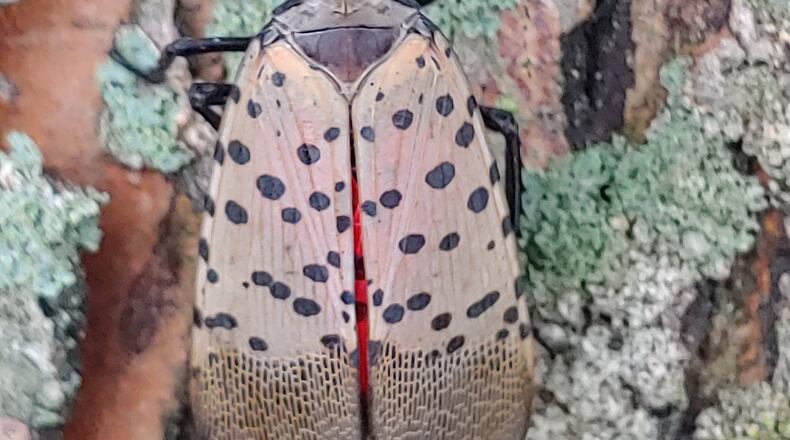We are asking people to be on the lookout for this pest and to report to the Ohio Department of Agriculture or to your local county Extension office is you see it. Adults are easy to spot while nymphs are a bit more challenging.
SLF is a planthopper adults and nymphs feed on another invasive species, the tree of heaven, or Ailanthus altissima. The female trees of this species are in full bloom right now and easy to spot.
Familiarize yourself with this tree and if you see it, check it out. There are male and female tree of heaven, and the males won’t be as visible.
Adult SLFs are approximately one inch long and one-half inch wide when at rest. They are not good fliers but rather hoppers. When they spread their wings, they are about one and a half inches wide.
The front wings are a translucent gray with black spots that transition to a black tiled pattern at the tips. The hind wings are red with patches of black and white. They are much more noticeable when their wings are spread.
The nymphs are much more difficult to spot. The first three instars (stages) are black and white, and the fourth instar is red. They are much smaller than the adults. Both adults and nymphs suck juices from the plant.
The biggest problem that I have seen due to this pest is the annoying honeydew secretion and the sooty mold that occurs on the honeydew. The SLF is a sucker. The sucking of the juices results in and excretion of honeydew from the hind end.
Anywhere the SLF is feeding, there will be honeydew on everything underneath. The black sooty mold then grows on the honeydew. This is the most annoying part. It can be on cars, sidewalks, streets, walls, patio furniture, and essentially anything that sits under the SLF feeding site.
The honeydew, a sticky sweet substance, is also very attractive to other insects and wasps. These are also annoying.
SLF won’t kill a plant outright, but it may weaken it and open it up to other pest pressures. It will, however, do significant damage to crops such as grapes and apples.
Sharing your outdoor space with the SLF is no fun. Just ask someone who has experienced an outbreak.
There is no doubt in my mind that we will see them, it’s just a matter of time. Please feel free to send me photos if you suspect that you find them. Familiarize yourself with the tree of heaven as well as the SLF itself.
Pamela Corle-Bennett is the state master gardener volunteer coordinator and horticulture educator for Ohio State University Extension. Contact her by email at bennett.27@osu.edu.
Credit: Contributed
Credit: Contributed
About the Author

